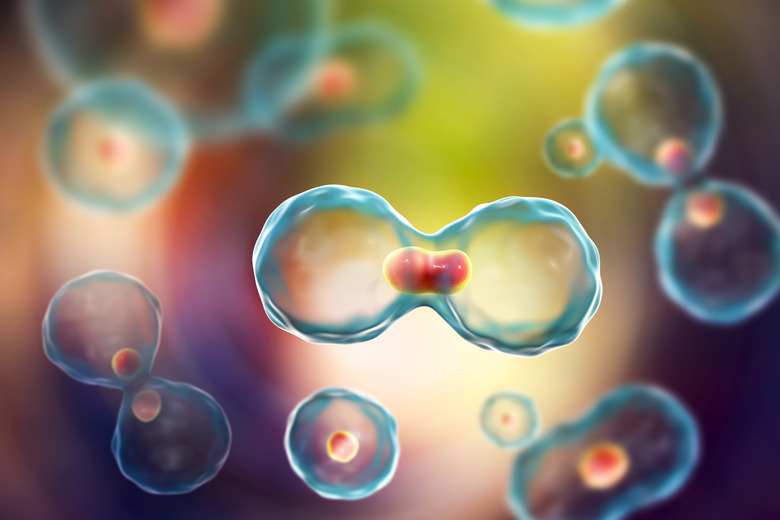How Does The Concentration Of A Solution Affect Osmosis?
Osmosis is a process that occurs between two containers separated by a semi-permeable barrier. If the barrier has pores large enough to allow water molecules to pass but small enough to block the molecules of a solute, water will flow from the side with the smaller concentration of solute to the side with the larger concentration. This process continues until either the concentration of solute is equal on both sides or the pressure resisting volume change on the side with the greater concentration exceeds the force driving the water through the barrier. This pressure is osmotic or hydrostatic pressure, and it varies directly with the difference in solute concentration between the two sides.
TL;DR (Too Long; Didn't Read)
The osmotic pressure driving water across an impermeable barrier increases with the difference in solute concentrations on either side of the barrier. In a solution with more than one solute, sum the concentrations of all the solutes to determine the total solute concentration. Osmotic pressure depends only on the number of solute particles, not on their composition.
Osmotic (Hydrostatic) Pressure
Osmotic (Hydrostatic) Pressure
The actual microscopic process that drives osmosis is a bit mysterious, but scientists describe it this way: Water molecules are is a state of constant motion, and they migrate freely throughout an unrestricted container to equalize their concentration. If you insert a barrier into the container through which they can pass, they will do so. However, if one side of the barrier contains a solution with particles too large to get through the barrier, the water molecules passing through from the other side have to share space with them. The volume on the side with the solute increases until the number of water molecules on both sides is equal.
Increasing the concentration of solute reduces the space available for water molecules, which reduces their numbers. This in turn increases the tendency of the water to flow into that side from the other side. To anthropomorphize slightly, the greater the difference in concentration of water molecules, the more they "want" to move across the barrier to the side containing the solute.
Scientists call this craving osmotic pressure or hydrostatic pressure, and it's a measurable quantity. Put a lid on a rigid container to prevent the volume from changing and measure the pressure needed to keep the water from rising while you measure the concentration of the solution on the side with the most solute. When no further change in concentration occurs, the pressure you're exerting on the cover is the osmotic pressure, assuming the concentrations on both sides haven't equalized.
Relating Osmotic Pressure to Solute Concentration
Relating Osmotic Pressure to Solute Concentration
In most real situations, such as roots drawing moisture from the ground or cells exchanging fluids with their surroundings, a certain concentration of solutes exists on both sides of a semi-permeable barrier, such as a root or cell wall. Osmosis occurs as long as the concentrations are different, and the osmotic pressure is directly proportional to the concentration difference. In mathematical terms:
**P = RT(∆C)**
where T is the temperature in Kelvins, ∆C is the difference in concentrations and R is the ideal gas constant.
Osmotic pressure doesn't depend on the size of the solute molecules or their composition. It only depends on how many of them there are. Thus, if more than one solute is present in a solution, the osmotic pressure is:
**P = RT (C1 + C2 +...Cn)**
where C1 is the concentration of solute one, and so on.
Test It Yourself
Test It Yourself
It's easy to get a quick idea of the effect of concentration on osmotic pressure. Mix a tablespoon of salt in a glass of water and put in a carrot. Water will flow out of the carrot into the salty water by osmosis, and the carrot will shrivel. Now increase the salt concentration to two or three tablespoons and record how much more quickly and completely the carrot shrivels.
The water in a carrot contains salt and other solutes, so the reverse will happen if you immerse it in distilled water: The carrot will swell. Add a small amount of salt and record how much less time it takes for the carrot to swell or whether it swells to the same size. If the carrot doesn't swell or shrivel, you've managed to make a solution that has the same salt concentration as the carrot.
Cite This Article
MLA
Deziel, Chris. "How Does The Concentration Of A Solution Affect Osmosis?" sciencing.com, https://www.sciencing.com/concentration-solution-affect-osmosis-8692240/. 26 April 2018.
APA
Deziel, Chris. (2018, April 26). How Does The Concentration Of A Solution Affect Osmosis?. sciencing.com. Retrieved from https://www.sciencing.com/concentration-solution-affect-osmosis-8692240/
Chicago
Deziel, Chris. How Does The Concentration Of A Solution Affect Osmosis? last modified March 24, 2022. https://www.sciencing.com/concentration-solution-affect-osmosis-8692240/
